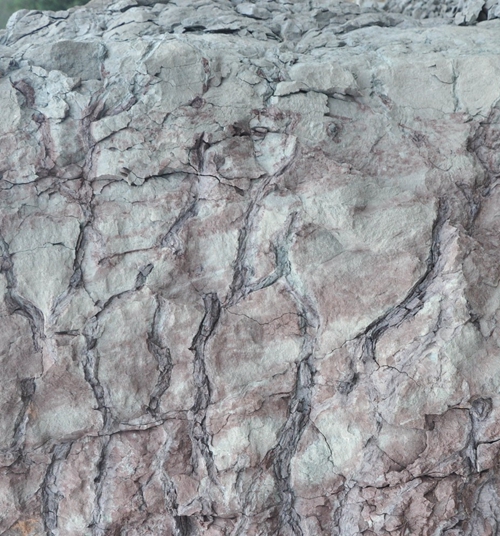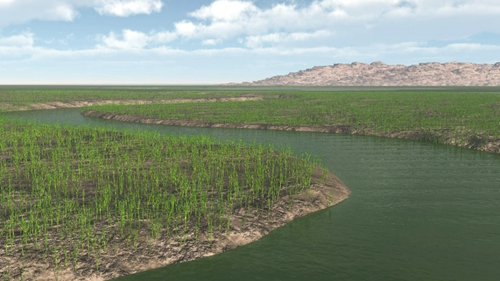PNAS封面图片:4.1亿年前的原始土壤及植物根状茎化石
2016年8月23日,国际著名学术期刊《美国国家科学院院刊》杂志在线发表了北京大学地空学院薛进庄与国内外多家研究机构合作完成题为Belowground rhizomes in paleosols: the hidden half of an Early Devonian vascular plant(古土壤中的地下根状茎:早泥盆世维管植物隐藏的另一半)的封面文章,论文揭示了早期维管植物在促进土壤圈形成以及增强地貌稳定性方面的显著作用。研究生邓珍珍、黄璞为论文共同第一作者,研究被PNAS遴选为34期的封面和亮点论文。
维管植物在志留—泥盆纪时期成功占领陆地,奠定了后续陆地生物和生态系统演化的基础,对地球系统产生了深远的影响。植物的地下组织如根或根状茎是它们与外部环境相互作用的直接媒介。然而,早期植物的根或根状茎化石非常少见,这制约着人们对早期陆地生态系统中植物与土壤相互作用的认识。薛进庄团队基于我国云南的一套形成于大约4.1亿年前(泥盆纪早期)、地质学上称为“徐家冲组”的地层,通过细致的沉积学研究,揭示出徐家冲组代表河流沉积物记录了频繁的洪泛事件;洪泛平原上发育最古老的是具根系红层古土壤;徐家冲组体现出河道趋于稳定、洪泛平原厚度大、古土壤发育(累积厚度350余米)等沉积特征,这些特征在泥盆纪之前的时代(即维管植物主导陆地植被之前)是非常少见的。形态学观察和地球化学分析表明,徐家冲组红层古土壤形成于干湿交替的气候背景下,可归入初成土或钙化土,其中普遍含钙结核以及一类原始石松植物——镰蕨(Drepanophycus)的根状茎。前人研究多关注化石植物的地上部分,镰蕨被复原为数十厘米高的草本植物。但该团队发现,镰蕨可通过地下的根状茎克隆生长,形成庞大的长寿克隆体,在每立方米古土壤中,根状茎的总长度可达800至1300米,它们重复多次K-型或H-型分枝,形成复杂的网状结构。徐家冲组的单个红层古土壤厚度可达20米,根状茎贯穿其中,反映长期稳定的洪泛平原堆积和植被发育,以及植物克隆体对沉积物频繁埋藏的适应能力和顽强的扩展能力。作者们提出,庞大的根状茎网状系统可增进河流沉积物的抗侵蚀能力,促进成土作用,从而增强河流地貌的稳定性、提高早期土壤的固碳能力,因此在植物登陆初期,克隆生长是原始的维管植物作用于地球系统的一种重要机制。4亿年以来,根状茎克隆生长普遍存在于各类植被和陆地环境中,但它们的地质意义却常被人们所忽视。在现代生态系统中,克隆植物仍起着非常重要的作用,如沙丘上的沙鞭(Psammochloa villosa)和人们熟知的竹子。
评审人表示很少见到如此strong、complete和clean的稿件(“…rarely have I come across a manuscript as strong, complete, and clean as this”);另一评审人认为,论文对研究早期植物对地球系统演化的影响提供了非常有价值的贡献(“a very valuable contribution to the literature on the impact of early plant life on the evolution of the Earth System”)。

PNAS封面图片:4.1亿年前的原始土壤及植物根状茎化石

泥盆纪早期的河流与洪泛平原植被景观复原(徐家冲组邓珍珍绘制)
原文链接:
Belowground rhizomes in paleosols: The hidden half of an Early Devonian vascular plant
原文摘要:
The colonization of terrestrial environments by rooted vascular plants had far-reaching impacts on the Earth system. However, the belowground structures of early vascular plants are rarely documented, and thus the plant−soil interactions in early terrestrial ecosystems are poorly understood. Here we report the earliest rooted paleosols (fossil soils) in Asia from Early Devonian deposits of Yunnan, China. Plant traces are extensive within the soil and occur as complex network-like structures, which are interpreted as representing long-lived, belowground rhizomes of the basal lycopsid Drepanophycus. The rhizomes produced large clones and helped the plant survive frequent sediment burial in well-drained soils within a seasonal wet−dry climate zone. Rhizome networks contributed to the accumulation and pedogenesis of floodplain sediments and increased the soil stabilizing effects of early plants. Predating the appearance of trees with deep roots in the Middle Devonian, plant rhizomes have long functioned in the belowground soil ecosystem. This study presents strong, direct evidence for plant−soil interactions at an early stage of vascular plant radiation. Soil stabilization by complex rhizome systems was apparently widespread, and contributed to landscape modification at an earlier time than had been appreciated.
作者:薛进庄

